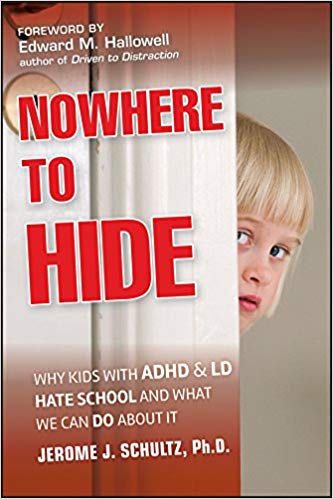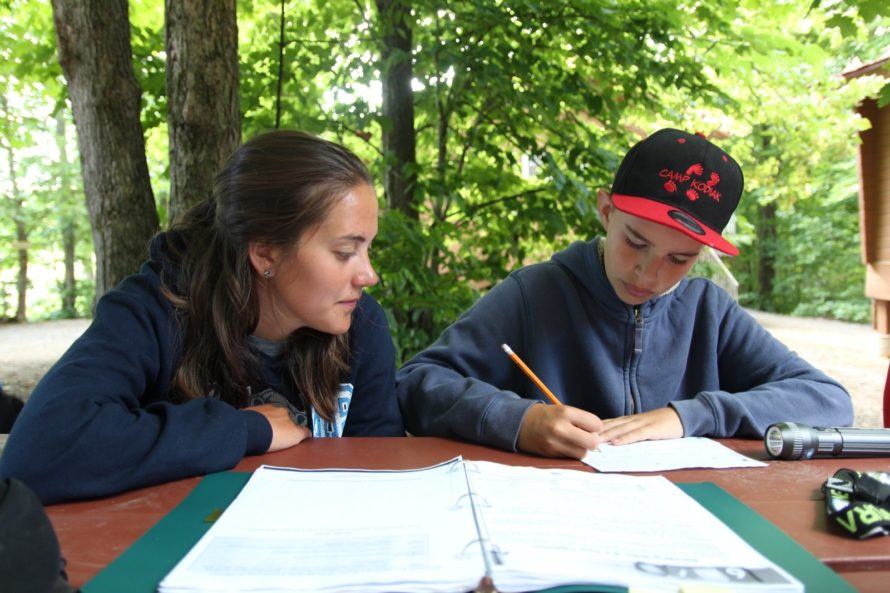I picked up this book with a specific child in mind. One of my students at school is bright, athletic, social, and capable in so many ways, but he has learning and attention problems, and he is completely disengaged in school. A victim of the “Fortnite” generation, he spends too many hours playing video games when he should be playing (or eating, sleeping, or doing homework), and he comes to school tired, bored, and not at all ready to learn. Now in grade 6, he is getting ready to switch schools next year, and his classroom teacher and I are worried about him. Why doesn’t he seem to care, and what can we do to make things better for him? I recognized my student in the pages of this book, and I thought that some of you might recognize your own children here as well.

In Nowhere to Hide, Dr. Jerome Schultz writes about the experiences of students with learning disabilities (LD) and Attention Deficit Hyperactivity Disorder (ADHD) in school. He states that so many of our students with LD and ADHD disengage or actively reject school in order to protect themselves from the stress that is central to their school experiences. Every day, students are put in situations where they have little control, little chance of success, and a high probability of being embarrassed or ashamed. Therefore, their brains shift into survival mode to try to protect them from these stressors and activate fight, flight, or freeze responses, what Dr. Schultz calls “saving FASE” (fear, anxiety, stress, escape). In order to “save FASE,” students need to feel in control of their environment. Depending on the situation and personality of the student, that might look like apathy and disengagement, or, in some cases, anger and aggression. If the situation continues unchanged, the student will experience chronic stress, which can lead to burnout, helplessness, and even impaired cognitive functioning.
Teachers and parents don’t intend to put children and teens under stress. Unfortunately, the situations that children with LD and ADHD naturally find themselves in are ripe with stress because being asked to do something that you feel you cannot succeed at—things like reading, mathematics, sitting still, or making friends—is inherently stressful. “For kids with LD and ADHD, stress lives in the space between ‘I need to’ and ‘I don’t know how to.’” (p. 107). These children live in constant fear of failing, disappointing others, and being embarrassed. This fear is sticky; it attaches itself to the source of the fear and then over-generalizes to produce a negative reaction when a similar situation presents itself.
Consider the student whose grade 7 math teacher embarrassed him by assigning work that was too difficult, not providing the necessary support to succeed, and singling him out for his failures. Over the course of the school year, that student made a strong connection between fear, embarrassment, and math, so the grade 8 teacher has a tremendous hurdle to overcome in order to sever the connection and allow the student to approach math learning with an open, relaxed mind. The same can be true of social situations. A child who has been bullied in the past might experience extreme stress when faced with any new social situation and might react by avoiding or actively rejecting new peers.
Just as anxiety and helplessness can be learned, so, too, can safety, and this “learned safety” (the confidence learned from experiences that show that a person has the skill to protect themselves from a stressful situation) plays an important role in combatting stress and re-regulating emotions. Teachers and parents are critical in developing learned safety by helping kids gain control of their learning situations in ways that are empowering and productive, thereby reducing stress and activating their learning brains. Dr. Schultz proposes his “DE-STRESS” model to do just that.
- Define: Define the student’s learning profile, preferably through a thorough psychoeducational assessment that specifically highlights strengths and also evaluates the student’s emotional well-being.
- Educate: Educate the student about their own learning profile. Help them develop self-awareness and reflect on how their learning profile impacts their life and school work so that they can take an active role in their own learning and success.
- Speculate: Help the student look ahead to what hurdles they will likely face in an upcoming situation, what personal assets will help, and what tools or strategies might support them.
- Teach: Teach skills, techniques, strategies, and tool use to help them be successful.
- Reduce Threat: Create positive learning and social environments. Help the student recognize signs of stress in themselves and techniques to minimize or de-activate the stress. Ensure they have areas of their life in which they feel confident and successful and try to replicate these conditions in the classroom.
- Exercise: Take care of the physical needs of the student by ensure that they are getting sufficient exercise, proper nutrition, and good hydration.
- Success: Provide plenty of opportunities for the student to display their skills and encourage honest self-appraisal. Teach them to identify the strategies and behaviours that led to their success in the past and present so that they can continue them in the future.
- Strategize: Make plans to maximize the chance of success in the future.
The last section of the book provides specific suggestions for how teachers and parents can apply the DE-STRESS model. For example, teachers can take the pressure off by encouraging partner work (e.g., discuss the answer with a partner and share your partner’s answer if you think it is correct), provide choice of how students can present their learning (e.g., through a written report, oral presentation, video, poster) or even answer a question (e.g., in writing, orally, or through a pictorial representation), and remind students about past successes when presenting them with a new challenge. For their part, parents should help their children identify their “island of competence” and nurture their skills so that they can truly excel. They could adopt a calm, relaxed parenting style and stay focused on their child’s strengths. Parents are encouraged to become involved in the school by volunteering or joining the school council. And finally, they are urged to set strict limits around video game use; even though kids look fully engaged while they are playing, video games disengage the mind, and for many of our kids, they can become addictive and contribute to the counterproductive habits that make success in school difficult: poor sleep, social isolation, and filling time that could be better used in furthering goals, completing assignments, and valuable self-care such as exercising.
I recognized what we do at Camp Kodiak in the DE-STRESS model. While we don’t provide psychoeducational assessments, we do encourage campers and staff to talk about how their learning disabilities, ADHD, or ASD affects them and what they do to turn the situations around and use their learning profiles to their own advantage. We offer over 50 activities for kids to try so that each of them can find their own islands of competence. And we encourage campers to try things that school friends and siblings might not have experience with—stained glass, wakeboarding, kayaking, fencing, and so many others—so that they might go home with cool new skills that are uniquely theirs. We celebrate successes privately through quiet conversations and publicly through “merit announcements” in the dining hall. We reduce or eliminate competition and try to create a non-threatening environment, and of course, campers get a lot of fresh air and exercise and very limited access to electronics.
I recommend this book. It provides insight into the hidden struggles kids often face, ones that are hidden behind behaviours that become the focus of the adults in their lives. Hopefully, with understanding and proper intervention, our kids can stop trying to hide and come out into the spotlight where they belong.

